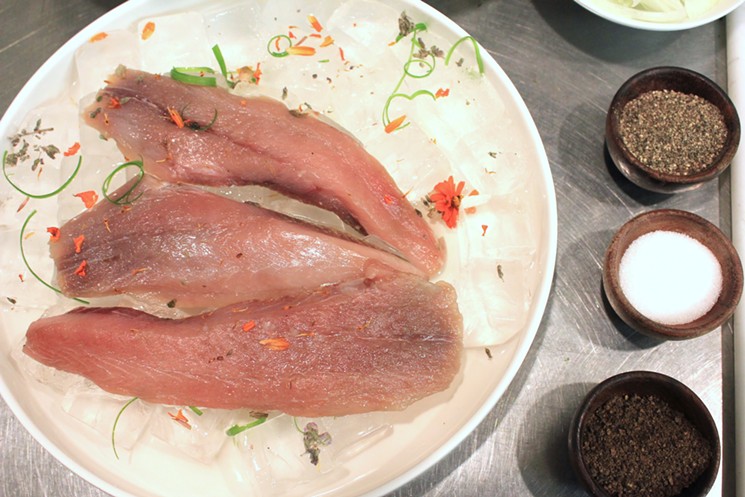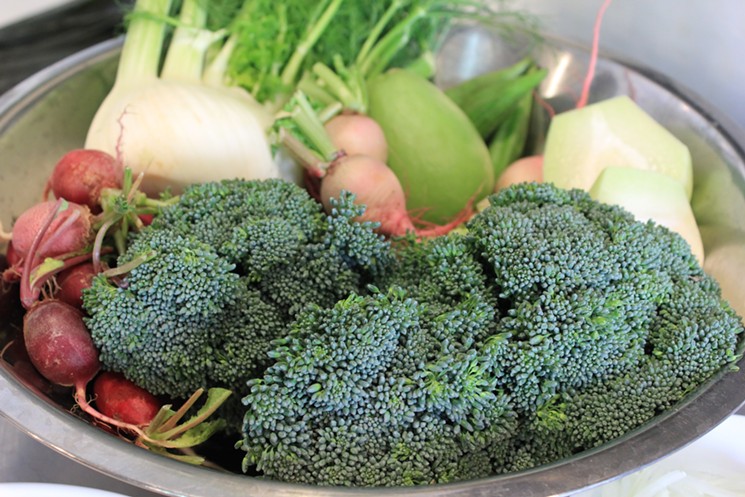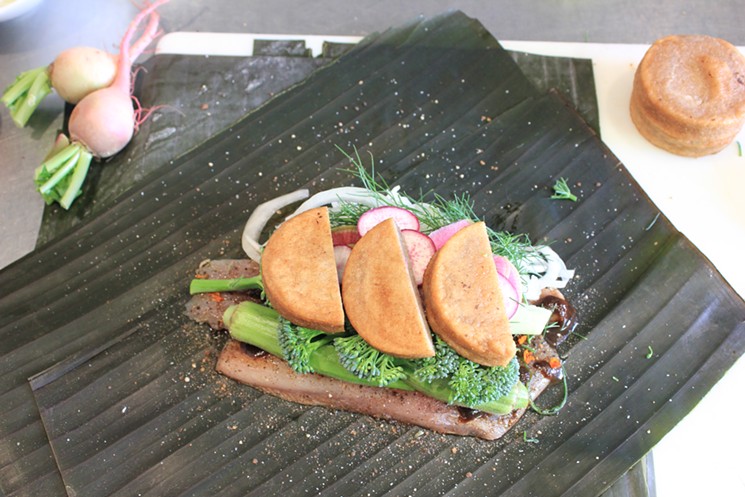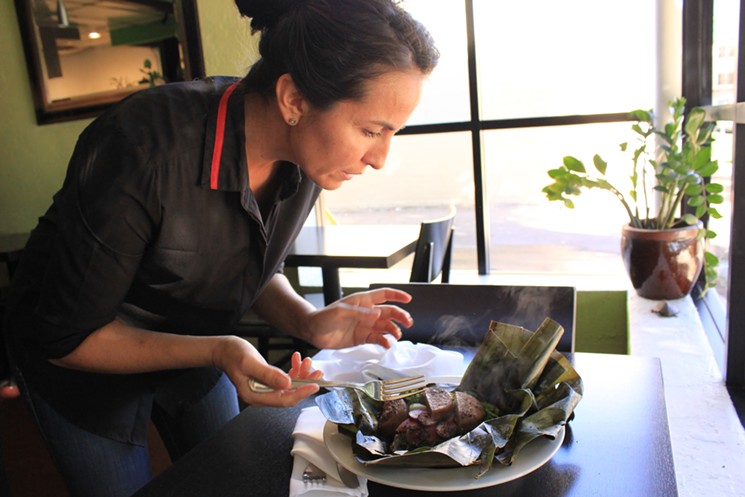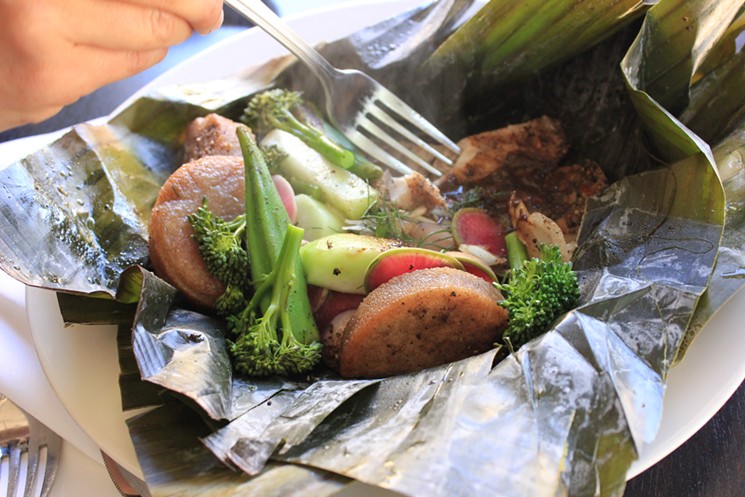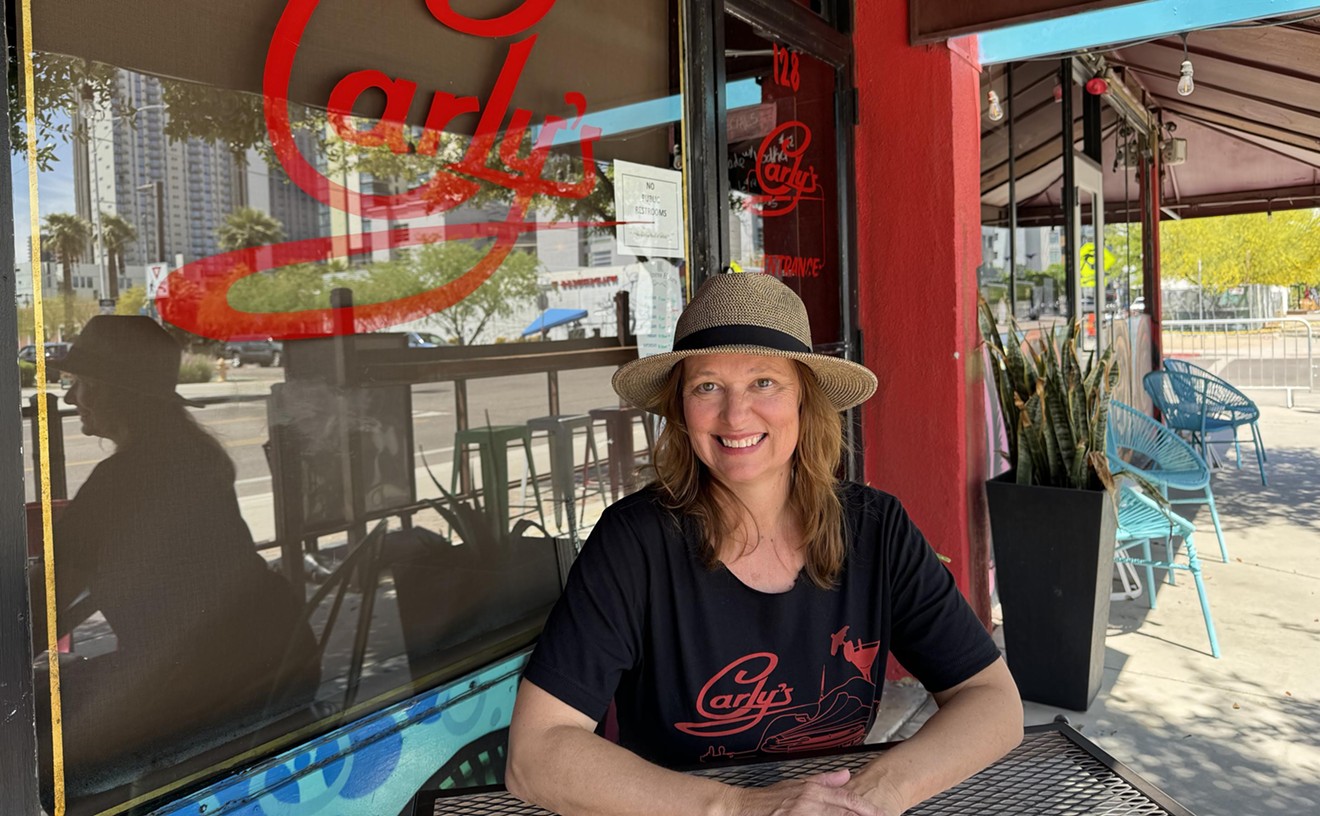When Danielle Leoni, chef at The Breadfruit & Rum Bar, falls deeply into a conversation about food, she may drop a phrase that will make you do a double take. You may ask her: So you cook vermillion snapper but not red snapper? And she may say the phrase a second time. Now you know you're not hearing things. Leoni just dropped a Jamaican "ya mon." She has so immersed herself in the Caribbean island's food culture that fragments of its speech have become her own.
"Ya mon," she tells me in her kitchen, standing over fish fillets the color of pencil erasers. "I've made this dish with red drum and vermilion snapper. Vermilion is different from red."
Leoni is about to make the dish in question, fish cooked in a banana leaf. It's one of The Breadfruit's staples, a paragon of the kind of dish one would eat in Jamaica, a preparation that speaks to what Leoni cooks and what The Breadfruit is.
"The Breadfruit," Leoni says, "is a marriage of what is local and what is tropical.” In the case of her steamed fish, the local comes from the heap of vegetables tucked under the banana leaves, the tropical from everything else. Leoni and her husband, Dwayne Allen, opened The Breadfruit in 2008 to bring Phoenix the flavors of Allen's home island.
Those flavors are often elemental. With her steamed fish, the starting point is leaf and sea.
“It’s prepared in a very traditional way, which is wrapping it in a banana leaf,” Leoni says. “You pull your fish offshore and you have nothing but sand and maybe a fire. So you pick a leaf off a tree and you wrap it up.”
Leoni operates on Pierce Street in Phoenix. She can't exactly nab a finned beaut from the water. But she has relationships with folks who can. The day I was in, Leoni was working with 20 pounds of fish from Sea to Table, a purveyor. The catch came from fishermen in Florida who used nets, a less destructive method than lines. The fish was striped mullet, a more sustainable mullet species.
Sustainability drives Leoni's approach to seafood.
In June, Leoni participated in a pilot seafood program at the invitation of the James Beard Foundation. The JBF-designed program educated select chefs on how to source sustainable seafood. This is a whale of a topic, one with all kinds of murky nuances. The program took a deep dive, exploring details like which kinds of mullet (and other fish) are sustainable, what kind of boats to get them from, how they are fished, what docks handle them best, and so on. For her effort, Leoni received a “Seafood Sustainability Seal” from the foundation.
This is how we arrive at mullet over snapper (and, in other iterations of the banana-leaf-steamed fish, vermillion snapper over red).
The warm-water fish is hard to work with. “Mullet is known as the most under-loved fish in the sea,” Leoni says. She tells tales of how tricky the fish are to catch, of how excruciating they are to fabricate, of standing for two hours and making surgical cuts around curved rib cages and gnarly bones. Yes, it took two hours to prep 20 pounds of mullet to the point that they were ready for step one of the cooking.“Mullet is known as the most under-loved fish in the sea,” Leoni says.
tweet this
Lowering the love factor even further, five pounds of the 20 ended up being unusable pieces like bones. (She would turn these into fish stock.)
Leoni takes pride in using a sustainable but difficult fish like mullet. Keeping to fish like mullet allows her to fully use her skills as a chef as well as her platform. Mullet, in her opinion, is also a choice fish. “It has a beautiful, distinct flavor profile,”Leoni says.
She lays two glossy, pork-colored mullet fillets onto a thin stack of banana leaves. These banana leaves, veined and shiny, will imbue the fish with vegetal flavor. Leoni scatters salt, pepper, and pimento (Jamaican allspice) onto six ounces of fish. She spreads on red-brown pickapeppa sauce, a culinary staple in Jamaica made from cane vinegar, tomatoes, raisins, ginger, clove, mango, orange peels, and other ingredients. The musky sauce has been aged in oak barrels. It costs her $75 a gallon.
The first layers of flavorings cast, Leoni starts placing vegetables atop the mullet. Arrived that day from Maya’s Farm and McClendon Select Organic Farm, the vegetables have been chilling on a bed of ice. Leoni’s hands move deliberately. She stacks plant forms and colors of all kinds: okra, yellow onion, broccoli, fennel fronds and bulb, and chayote, a squash-like vegetable.
She then adds three halves of bammy.
Bammy, together with banana leaf, pimento, and pickapeppa sauce, are the ingredients that make this dish Jamaican. Bammy are discs of flatbread made from cassava, a whitish shrub seminal to the cooking of some Latin American countries.
Leoni makes bammy herself. This is borderline insane. Bammy are difficult to craft, and most restaurants that use them get them pre-made. Leoni makes hers from cassava flour, coconut milk, sea salt, and water. The discs are dense. They look like hockey pucks made from pressed brown sugar.
Once the bammy crown the stack, Leoni rolls it all in banana leaves.
The primal-looking package goes into a baking dish. Leoni adds water, which helps the fish steam as it cooks in the oven. She knows how long the mullet takes to cook, and she cuts vegetables and bammy to a size that will allow them to be done at the same time as the fish.
We wait 20 minutes and chat.
She drops another “ya mon” or two as she runs over her culinary history. She didn’t attend culinary school. She had never worked in a kitchen before hers. She got another kind of culinary education, one from Allen’s family in Jamaica, in secluded places like the family farm in Madras. “The elders in his family were the only culinary training I ever had,” she says. “When I go to Jamaica, I am immersed in a true culinary heritage and tradition.”“The elders in his family were the only culinary training I ever had,” she says. “When I go to Jamaica, I am immersed in a true culinary heritage and tradition.”
tweet this
That education was about three years coming. Allen’s family didn’t let Leoni into the kitchen for her first several visits. Eventually, she was accepted into the inner circle and learned the family ways, a step down one fork in the road to where she is now.
The fish comes out, and Leoni unwraps the leaves. Steam coils billow and rise.
“I want to ask people to think differently about food,” she says as we get ready to taste the fish. This loops back to an earlier thought: “My endeavor is to elevate Jamaican cuisine so it can be on par with fine French food or proper Italian, you know what I mean? I want to take it out of weird ethnic third world food, kind of 'ehhhhh what is it,' to, yes, you want to eat it, even if you don’t have a full understanding of the cuisine.”
Leoni takes the first bite. She nods her approval. I fork up a taste from a flank uncovered by vegetables. The essences of the vegetables, banana leaf, and pickapeppa have seeped into the fish, bringing thin earthy vibes. So has the soul of the bammy, the nutty brown discs hot and chewy.
The striped mullet is simple and deeply satisfying. This way of cooking fish isn’t that different from the French en papillote or Italian al cartoccio, both methods for cooking fish in parchment. Banana leaf subs in for parchment; Pickapeppa and bammy for ingredients like butter, thyme, and white wine; ramshackle Caribbean skiffs for their Mediterranean analogs. On her own terms, taking the hard path at every turn, with the planet and localism at the forefront every possible step of the way, Leoni has elevated this simple beachside Jamaican dish the way she aims to.
The Breadfruit & Rum Bar. 108 East Pierce Street; 602-267-1266.
Monday to Thursday 5 p.m. to 10 p.m.; Friday and Saturday 5 p.m. to midnight; closed Monday


